[ad_1]
Existing since the time of the dinosaurs, turtles are the oldest reptile groups still alive today. They’ve been swimming and crawling the earth for over 220 million years, and probably still will after we’re gone.
Aquatic turtles typically spend most of their lives in various aquatic habitats, including freshwater ponds, rivers, and lakes. They’re adapted to have webbed feet and flatter shells to help them float and swim faster. However, they still need to bask in the sun occasionally.
While most turtles are considered endangered species, some of them are frequently adopted as pets.
In this article, we’ll go through a few of the aquatic turtles that are popular in the aquarium trade and discuss their unique care requirements for identification, habitat setup, lighting, heating, water quality, handling, and other details.
Types of Aquatic Turtles
1. Red-Eared Slider
| Scientific Name: | Trachemys scripta elegans |
| Family: | Emydidae |
| Care Level: | Intermediate to Advanced |
| Temperament: | Docile. Can become aggressive if not cared for properly or kept in a small space |
| Color: | Greenish with yellow markings and a red patch behind their eyes |
| Lifespan: | 20 to 40 years |
| Size: | Males: 8 – 10 inches Females: 10 – 13 inches |
| Diet: | Omnivorous. Fish, insects, aquatic plants. |
| Minimum Tank Size: | At least 75 gallons for adults |
| Temperature: | Basking: 90 – 95F Water: 75 – 82F |
| Water Conditions: | pH: 6.8 to 7.8 Moderately hard water |
| Tank Mate Compatibility | Similarly sized turtles |
Found in various aquatic habitats with abundant vegetation and basking spots, the Red-Eared Sliders are native to the southern United States and northern Mexico. They prefer slow-moving or still waters with sand and mud as substrates.
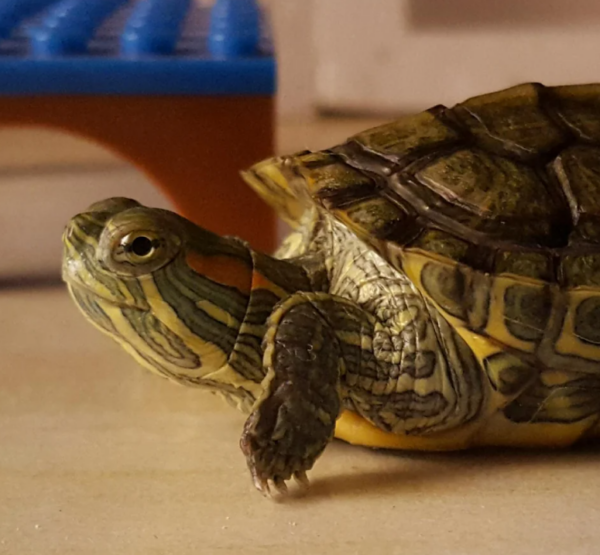
Appearance-wise, Red-Eared Sliders are quite vibrant and have a green or olive-colored carapace (top shell) with yellow markings. Their unique appearance, however, comes from the red or orange stripes behind their eyes, looking like red ears.
Their bottom shells (plastrons), in contrast, are yellow with dark markings. Their shell-built is streamlined and is suitable for aquatic activities.
Although Sliders somewhat tolerate the presence of other turtles in the tank, they are generally solitary creatures, with adult males known to be pretty territorial. Provide enough space if you’re keeping multiple turtles together.
Setting up an indoor or outdoor spacious habitat that mimics their natural environment is critical to keep Sliders healthy. Ensure they have ample basking area in the form of logs, platforms, and rocks.
As for lighting and heating, a basking light (for heating) and a UVB light are essential in Red-Eared Slider tanks. Try to follow a 12-hour cycle with the lights to resemble the day-night cycle.
Apart from that, adequate filtration, high-quality pellets, live food, and leafy greens should be arranged to keep them healthy. Bear in mind that the Sliders don’t like to be touched or handled frequently. Be gentle and avoid holding them too high when handling them.
2. Painted Turtle
| Scientific Name: | Chrysemys picta |
| Family: | Emydidae |
| Care Level: | Beginner to Intermediate |
| Temperament: | Docile and peaceful. Can become aggressive and skittish if not handled properly. |
| Color: | Dark green or black top shell with bright red, yellow, and orange markings. |
| Lifespan: | 20 to 40 years |
| Size: | 6 – 7 inches |
| Diet: | Omnivorous. Animal matter, insects, aquatic plants |
| Minimum Tank Size: | 40 gallons or more |
| Temperature: | Basking: 85 – 90FWater: 70 – 75F |
| Water Conditions: | pH: 6.5 to 7.5Moderately hard water |
| Tank Mate Compatibility | Other turtles of similar size |
Inhabiting ponds, lakes, and marshes of North America, the Painted Turtles prefer to live in slow-moving waters. Basking in the sun, they often are seen resting on floating logs and rocks near the water’s edge. Their natural substrate choices are sand and small gravel.
Growing up to around 7 inches, Painted Turtles are relatively smaller in size compared to other aquatic turtle types. They have a smooth, oval-shaped top shell with black or dark green base coloration and vibrant red and yellow markings on the edges and underside of the top shell.
Their bottom shells are usually pretty underwhelming, with a yellow base and black markings.
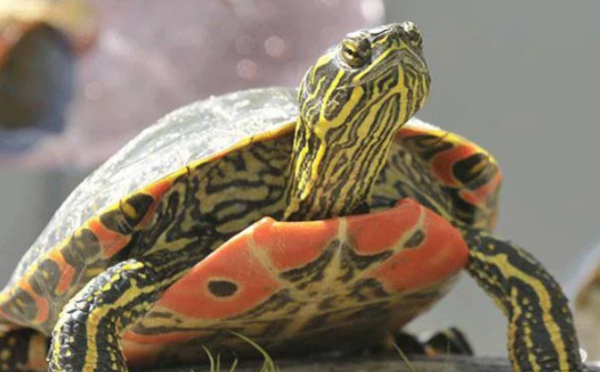
Painted Turtles are pretty peaceful and often are found to be living in groups. Especially when basking. Their basking behavior helps them maintain their internal temperature and is also essential to absorb UV rays, which are critical for strengthening their shell.
Like any other basking turtle, they require both heating and UVB lighting systems. They also require clean water with slow movement and an omnivorous diet to thrive in your tank. Introduce a few similar aquatic turtles to keep your Painted buddy company.
Aquatic turtles, in general, have pretty sensitive top shells to sense danger. Although Painted Turtles can be handled, you are advised not to do it frequently to the extent of it becoming aggressive and developing health issues.
3. Map Turtle
| Scientific Name: | Graptemys geographica |
| Family: | Emydidae |
| Care Level: | Intermediate |
| Temperament: | Skittish around humans. Friendly with other turtles. |
| Color: | Darker background with light-colored markings. |
| Lifespan: | 20 to 30 years |
| Size: | Up to 10 inches |
| Diet: | Carnivorous, but occasionally eats leafy veggies |
| Minimum Tank Size: | 55 gallons for adults |
| Temperature: | Basking: 85 – 90F Water: 75 – 80F |
| Water Conditions: | pH: 6.5 to 7.5 Moderately hard water |
| Tank Mate Compatibility | Other turtles of similar size |
Preferring sandy and rocky substrates, the Map Turtle is native to North American rivers, streams, and large lakes with moderate currents. They prefer clear water and often bask on rocks and other submerged structures.
Resembling the contour lines on a map, the top shells of the Map Turtles are usually brown or olive-colored with yellow lines and markings. They have a smooth, oval-shaped carapace to swim in the rivers and streams.
Like most other aquatic turtles, the Map Turtles aren’t as social as other pets. But, they’ve been observed to form small groups in the wild. They also endure the presence of other similar turtle species in the tank.
Map Turtles dive quickly to the safety of water when startled.
Equipped with a reliable filter to deliver clean water, your Map Turtle tank should have enough space for it to swim and bask. Like other turtle species, you need to have a heating lamp and a UVB lamp to deliver its basking and calcium metabolic demands.
Map Turtles mostly prefer a carnivorous diet of live/frozen worms, small fish, and crickets, but they also occasionally crave leafy vegetables and aquatic plants. Ensure to offer them high-quality commercial pellets with occasional treats of live fish and insects.
4. Musk Turtle
| Scientific Name: | Sternotherus odoratus |
| Family: | Kinosternidae |
| Care Level: | Beginner to Intermediate |
| Temperament: | Shy and reclusive. Love to be left alone. |
| Color: | Dark-colored top shell with a distinct ridge running down the center. |
| Lifespan: | 20 to 30 years |
| Size: | 3 to 5 inches |
| Diet: | Omnivorous |
| Minimum Tank Size: | 40 gallons or more for adults |
| Temperature: | Basking: 85 – 90FWater: 75 – 80F |
| Water Conditions: | pH: 6.5 – 7.5Moderate water hardness |
| Tank Mate Compatibility | Best to be kept alone or with similarly sized turtles |
Native to North American slow-moving rivers, lakes, and marshes, the Musk Turtle prefers soft muddy substrate with abundant aquatic vegetation. They’re well adapted to both freshwater and brackish water environments.
Musk Turtles are small and have a smooth, flattened top shell that is usually brown or black with serrated edges. Their bottom shell is a bit reduced in size and fails to cover their entire body—leaving limbs and part of their head exposed.
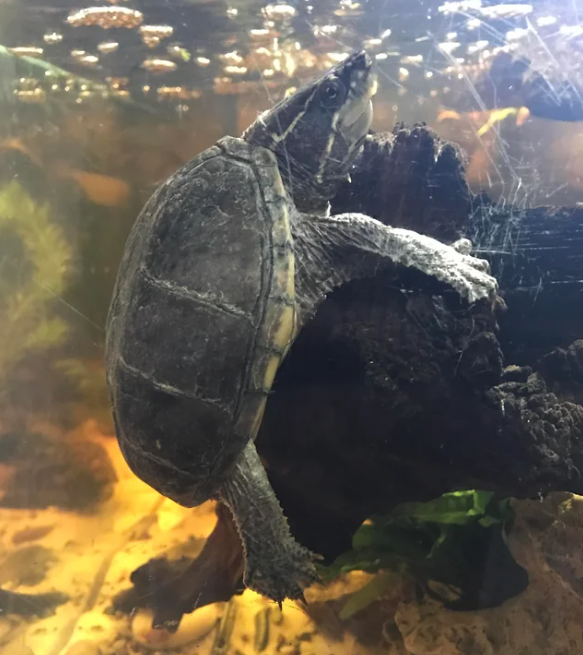
They’re usually solitary and become aggressive when kept with other turtles. Male Musks are more aggressive and territorial than their female counterparts. Moreover, they’re so threatened by other species that they emit a strong “musk” to drive them and the predators away.
The tank setup is critical for Musk Turtles to provide them with enough space to swim and bask effectively. You also need to be careful with the soft substrate choice to allow for their natural digging behavior.
The Musks also need a heating lamp and a powerful UVB lamp to maintain their calcium metabolism and overall well-being. The photoperiod (day-night cycle) should be consistent, with around 12 hours each cycle, to sustain Musk Turtles.
As for handling, they can be handled occasionally, but they may get stressed if handled too much or held too high above the ground.
5. Eastern Box Turtle
| Scientific Name: | Terrapene carolina |
| Family: | Emydidae |
| Care Level: | Intermediate |
| Temperament: | Shy and docile. Primarily terrestrial. |
| Color: | Olive or dark brown top shelf with yellow or red markings. |
| Lifespan: | 40 – 50+ years |
| Size: | 4.5 to 6 inches |
| Diet: | Omnivorous |
| Minimum Tank Size: | 50 gallons for adults |
| Temperature: | Basking: 85 – 90FWater: 75 – 85F |
| Water Conditions: | pH: 6.0 – 7.5 Prefers high humidity |
| Tank Mate Compatibility | Should be kept alone |
Mostly terrestrial, meaning they spend most of their time on land, Eastern Box Turtles inhabit deciduous forests, marshy areas, and grasslands of the eastern United States. They prefer areas with moderate vegetation cover and open spaces. Their natural substrate choice includes leaf litter, loamy soil, and sand.
Visually, they’re quite striking with a high-domed top shell and a hinged plastron. Their top shell is usually brown and black with yellow or orange patterns all over. Their bottom shell is typically yellow or orange with black blotches. The most distinguishing feature of Eastern Boxes is their eyes with an orange or yellow hue.
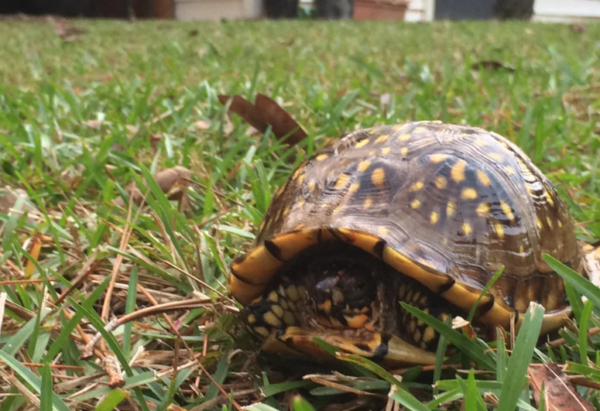
Males and females of this species can be differentiated by their eye color and the shape of the carapace.
They often prefer to spend time alone and aren’t highly social. But, they tolerate other turtles in their vicinity to an extent but never create a bond. Eastern Box Turtles have the unique ability to completely seal their shell. When threatened, they retract their head, tail, and limbs inside and employ the hinged plastron to shut themselves off.
When setting up their tank, focus more on the terrestrial part, including caves, hiding spots, logs, and leaf litter to mimic their natural habitat. The water should be shallow enough for the Box to drink and soak comfortably. UVB and basking lights also are critical for their well-being.
6. Asian Box Turtle
| Scientific Name: | Cuora amboinensis |
| Family: | Geoemydidae |
| Care Level: | Intermediate to Advanced |
| Temperament: | Generally solitary, can be stressed if handled frequently. |
| Color: | Dark-colored shell with lighter markings |
| Lifespan: | 30 to 40 years |
| Size: | Up to 8 inches |
| Diet: | Omnivorous |
| Minimum Tank Size: | 75 gallons or more for adults. |
| Temperature: | Basking: 85 – 90F Water: 75 – 80F80% humidity |
| Water Conditions: | pH: 6.0 to 7.5Moderate water hardness |
| Tank Mate Compatibility | Best to keep alone |
Inhabiting a variety of environments, including rainforests, grasslands, and lowlands, the Asian Box Turtle is native to China, Vietnam, and Thailand. They prefer habitats that are dense in vegetation and have access to both water and surface. They also enjoy a more muddy substrate.
Similar to Eastern Box Turtles, Asian Boxes also have a high-domed shape and a hinged bottom shell for protection. While they aren’t as vivid as their eastern counterpart, they also have a brown or olive-colored body with intricate patterns all over them. Some species of Asian Box Turtles also have patterns on their skins.
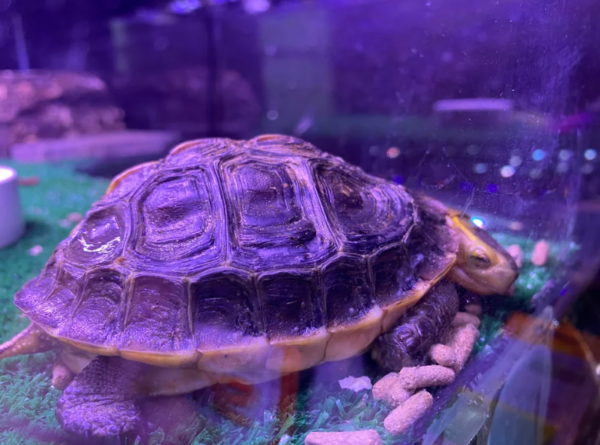
Often shy and reclusive, the Asian Box is a solitary and territorial animal. They protect themselves with their ability to seal their softer parts with the hinged shell mechanism. And similarly, they prefer to be left alone and don’t make bonds with other turtle species.
Focus on both the terrestrial and aquatic parts of the tank when setting it up. Provide a warm basking spot with high humidity and plants, hiding spots, rocks, and loamy soil. The aquatic area should be shallow enough to allow drinking and soaking.
10-12 hours of UVB and basking light are also critical requirements for Asian Box Turtles. Furthermore, children are particularly interested in this species too much due to their shell mechanism. Keep your children from petting them too frequently.
7. Reeve’s Turtle
| Scientific Name: | Mauremys reevesii |
| Family: | Geoemydidae |
| Care Level: | Beginner to Intermediate |
| Temperament: | Calm and social. |
| Color: | Dark-colored top shell with light-colored markings |
| Lifespan: | 20 years |
| Size: | 5 to 7 inches |
| Diet: | Omnivorous |
| Minimum Tank Size: | 50 gallons or more for adults |
| Temperature: | Basking: 85 to 90FWater: 75 to 80FHumidity: 70-80% |
| Water Conditions: | pH: 6.5 – 7.5Moderately hard water |
| Tank Mate Compatibility | Best to be kept alone, but can be kept with turtles of the same species. |
Also known as the Chinese Pond Turtle, Reeve’s Turtles are native to China, Taiwan, and Korea. They mostly live in slow-moving waters, such as ponds, lakes, and marshes, but are semi-aquatic reptiles that spend lots of time on the surface. Their natural substrate includes sand and mud.
Reeves are visually very appealing with their three-keeled carapace. Their top shell is dark brown or black with light-colored stripes running along the keels. The bottom shell is usually yellow with darker markings. Adapted to swimming, they have webbed feet and long claws.
Known for their shy and secretive nature, the Reeves are best kept in solitary. While they may encounter other turtles of the same species during breeding seasons, they don’t form a social bond. They also are equipped with the unique ability to retract their limbs and head inside their shell and seal it completely.
For Reeve’s Turtles, prepare a tank that offers both aquatic and terrestrial advantages. Provide hiding spots, logs, and leaf litter to mimic their natural basking environment. Furthermore, keep the aquatic part deep and large enough for it to swim and explore.
Also, use UVB and basking light to ensure proper calcium metabolism and overall health.
8. African Sideneck Turtle
| Scientific Name: | Pelomedusa subrufa |
| Family: | Pelomedusidae |
| Care Level: | Beginner to Intermediate |
| Temperament: | Docile and inactive |
| Color: | Dark-colored shell with yellow and orange markings |
| Lifespan: | 20 to 40+ years |
| Size: | Up to 10 inches |
| Diet: | Omnivorous |
| Minimum Tank Size: | 75 gallons or larger for adults |
| Temperature: | Basking: 85 – 90FWater: 75 – 80F |
| Water Conditions: | pH: 6.5 to 7.5Moderate water hardness |
| Tank Mate Compatibility | Best to keep them separate. |
Inhabiting slow-moving rivers, swamps, streams, and lakes, the African Sideneck Turtles are native to various regions in Africa. They prefer muddy and sandy substrates and prefer to have aquatic vegetation and submerged plants in their habitat.
Sidenecks have long necks that don’t fully retract into their shells. Rather they tuck their necks sideways, between the top and bottom shell, living up to their name. Their top shell color varies among species, from brown to olive. And the bottom shell is usually yellow or brown with dark markings.
Like other aquatic turtles, Sidenecks also aren’t highly social and prefer to live in solitary. While they may encounter other turtles during mating or basking in the wild, they don’t form social bonds.
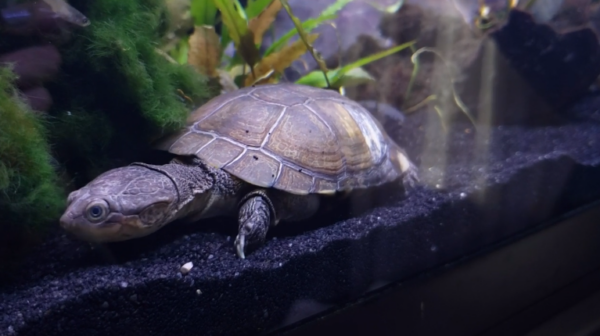
As a defensive behavior, they emit a foul-smelling liquid from their musk glands to deter predators.
A well-designed setup is essential to house African Sideneck Turtles. They need both aquatic and basking spaces to thrive. The aquatic zone should be able to completely submerge them and allow swimming, while the basking zone should be able to completely dry them off.
A full-spectrum UVB light and a basking light, provided at least 12 hours a day, are critical for the calcium metabolism and overall well-being of Sidenecks.
When handling them, keep them close to the ground and make sure not to startle them. They’re quite sensitive to touch and don’t like being roughly or frequently handled.
9. Matamata Turtle
| Scientific Name: | Chelus fimbriatus |
| Family: | Chelidae |
| Care Level: | Advanced |
| Temperament: | Solitary and reclusive. Shouldn’t be handled frequently |
| Color: | Brown and black top shell with spikes, resembling dried leaves. |
| Lifespan: | 30 to 50+ years |
| Size: | 18 – 20 inches |
| Diet: | Carnivorous |
| Minimum Tank Size: | Custom-built indoor pond with a basking area |
| Temperature: | Basking: 80 – 85F Water: 75 – 80F |
| Water Conditions: | pH: 6.5 to 7.5 Moderate water hardness |
| Tank Mate Compatibility | Should be kept alone. |
Native to Amazon and Orinoco Basins in South America, the Matamata is a unique aquatic turtle species that inhabits slow-moving rivers, swamps, and marshes. They prefer environments with muddy and sandy substrates with lots of vegetation.
Matamata Turtles are visually extraordinary. Their large, flat head and rough spiky skin resemble tea barks. It helps them blend in with the surroundings and remain unnoticed by both prey and predators. They have a snorkel-like nose to breathe while underwater.
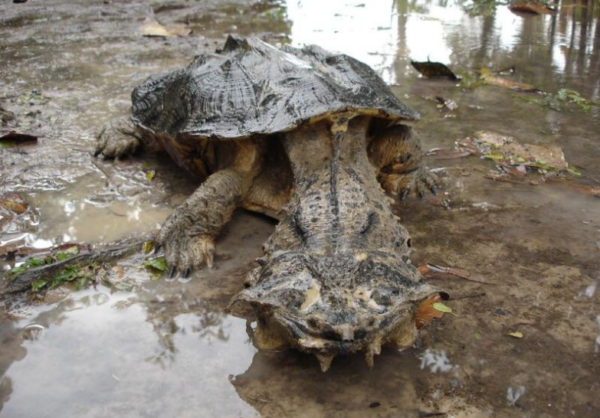
Matamata are highly solitary animals and don’t prefer the company of other turtles in their territory. They also exhibit a unique feeding behavior where they open their mouth and use a vacuum-like suction to capture and consume prey. Their large mouth and bigger esophagus allow them to swallow prey whole.
Their tank requirements also include an aquatic and a basking region. Ensure the water is deep enough for it to swim while the basking area is dry and warm enough to completely dry them off. Also, install UVB and basking lights while setting up their tanks.
Being carnivorous, their primary diet includes live fish and invertebrates. In captivity, feed them a variety of live/frozen food, including shrimp, fish, and worms. Despite their intriguing appearance, we recommend not handling them frequently. Being aquatic turtles, they get easily startled and stressed.
FAQ
Read-Eared Sliders are the most common types of aquatic turtles. They’re more friendly and sociable than other turtles and are pretty active, both in water and on land.
No, all types of turtles need to come to the surface to breathe. While some types of aquatic turtles can stay underwater for quite a long time, eventually, they need to breathe.
Tortoises are land reptiles and don’t go near water for anything. On the other hand, aquatic or semi-aquatic turtles need water to prey and swim.
The Bottom Line
We’ve discussed the 9 most popular types of aquatic turtles that you may keep as pets. While they require a bit more care than average aquarium fish, it’s a very rewarding experience. Moreover, as they live a long time, you may find a friend in the form of your pet turtle.
[ad_2]
Source link
